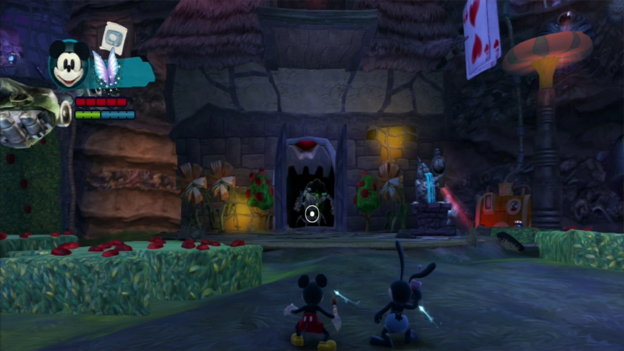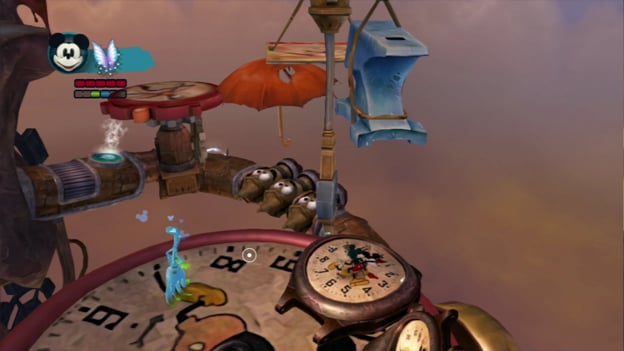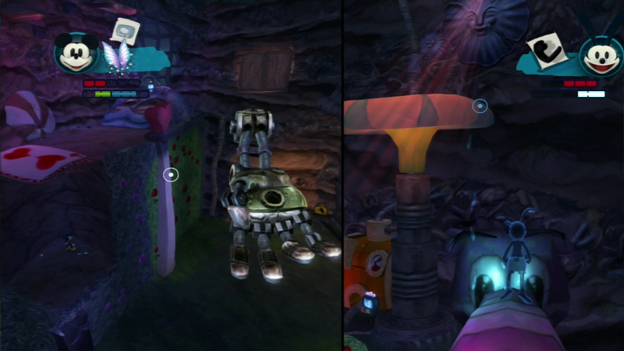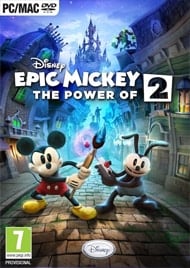Somewhere Between Epic and Mediocre
The original Epic Mickey was a controversial game—one I wanted to love but gave up on early into the experience. For some, the art style and Disney lore were enough, but I couldn’t get over the railroaded level design and terrible camera issues. With lessons learned from the problems of the first game, Junction Point is back with Disney Epic Mickey 2: The Power of Two. While it solves some of the problems the original game had, is that enough to make a great game?
In Epic Mickey, our heroic mouse made peace with Oswald the Lucky Rabbit, a long-abandoned former Disney cartoon star who was initially jealous of Mickey’s fame and fortune. Now Mickey and Oswald are teaming up to save the Disney cartoon Wasteland, which faces a variety of threats ranging from earthquakes to rampaging mechanical monsters to a supposedly reformed but obviously shady Mad Doctor. Mickey remains the star of the show with his paint and thinner powers, while Oswald plays second fiddle with a magic remote control that performs various electricity-related functions. There’s little to be said about the main story behind the game, except that it serves as a vehicle to take the player through the game world, and that it could have been far better than it is.

Just as the first game was, Epic Mickey is primarily a platformer, with a few RPG elements, like questline choices, built in. Most of the action involves jumping around the game world and using Mickey and Oswald’s tools to solve puzzles. Mickey will want to primarily use his paintbrush if the player wants to build up Wasteland as a community-minded place, or his thinner if the player wants to espouse the values of individualism and expediency. If that sounds heady in theory, it really isn’t in practice, as both approaches to the world involve using an analog stick to splash goop around the game world. In the end, being a paint player will usually cause ‘toons to like Mickey more, while being a thinner player is a more expedient and often less frustrating way to complete the game. Oswald’s electricity is morally neutral, sometimes used for paint-style outcomes and other times for thinner outcomes. The result of his actions isn’t always clear, which can be annoying to players who are trying to complete a pure paint or thinner outcome.
There are enemies to beat as well, and this time Oswald can assist Mickey by stunning them while Mickey jumps on them and uses either paint or thinner to defeat them. The camera isn’t too bad this time around, generally allowing the player a good view of the jumping puzzles and only occasionally becoming a problem in tight spaces. This makes platforming and combat a fair bit easier, which unfortunately exposes the fact that both of those elements are fairly rudimentary. There aren’t very many good platforming challenges in the game, but at least Oswald’s ability to carry Mickey around as he twirls his ears Rayman-style allows players to skip some of the more tedious jumping sequences. Combat has a bit more variety to it than the first Epic Mickey did, sometimes requiring a simple paint and thinner dump and sometimes requiring a more complex set of steps such as stunning and enemy so that Mickey can knock off its armor or bounce on a button that ejects a robot’s controller.
In an attempt to give the game more play value and depth, there are a ton of side quests available to complete. They’re all basic fetch, collection, or hidden item quests, though, and trying to complete most of them while playing through the main game is an exercise in either tedium or frustration. The liberal use of thinner is required for many of these quests, which can really mess up the choices the player is attempting to make during the main game. Anybody who enjoys the game enough to complete these quests may want to wait until after the main game is over in order to work on them, or at least wait until completing an area for the first time before returning to work on the quests. There are plenty of choices to be made in these side quests, but they tend to feel rather arbitrary, and you generally won’t care enough about any of the characters involved to be invested in the result of those choices.
Epic Mickey 2 feels a bit different depending on whether it’s played solo or in co-op mode. The main player controls Mickey at all times, and a second player can jump in as Oswald. There are pluses and minuses to both solo and co-op play. When solo, the full glory of the game world (Epic Mickey 2’s best feature) can be experienced without splitscreen, and there’s no need for the Mickey and Oswald players to constantly keep track of each other, which can be tedious. On the other hand, Oswald’s A.I. is nearly brain-dead, and he’s a massive pain to keep track of. He tends to jump in Mickey’s way at just the wrong moments, and when he’s needed, he’ll often be stuck at the bottom of a jumping puzzle or off getting himself killed. Pressing the B button supposedly summons Oswald, but it doesn’t always work, nor will Oswald always employ electricity when the player wants him to.

On the Wii U, Mickey is always controlled with the GamePad. On one hand, the GamePad’s screen is used to good effect with an interactive map. On the other hand, using the GamePad means that Mickey’s brush is controlled via analog stick instead of with the IR pointing ability of the Wiimote. This is a far less precise method of control, and can be particularly frustrating during boss battles, which often require Mickey to target small, fast-moving areas. In fact, it’s the boss battles that are particularly well-suited to co-op play, as having a player behind Oswald allows for the effective stunning and distracting of bosses so that Mickey can get his job done far more easily. A.I.-controlled Oswald is lucky if he can last a few minutes in a boss battle without getting himself killed, forget effectively assisting Mickey.
Despite all its issues, Epic Mickey 2 has its charming moments, and the game’s areas are a treasure trove for fans of Disney’s history. I was delighted to see the jug band from America Sings, the area dedicated to the Main Street Electric Parade, and even a sly reference to Disneyland’s classic but often-broken animatronic Lincoln exhibit. The secrets in the various levels can be fun to find, and occasionally the game manages to evoke feelings of genuine Disney magic. None of these moments are linked to the official story, though, and few are even related to its side quests. There’s a definite disconnect between the craftsmanship employed in creating the game’s world and that used to create the gameplay and main storyline, which is too bad.

The craftsmanship, at least, deserves praise. Epic Mickey 2 is gorgeous to look at and both delightful and creepy to explore. It may not be the grim dystopia that some gamers want the series to be, but just try using a bit of thinner on the buildings in the main town, and there are plenty of disturbing sights to behold behind the scenes. Other areas are simply lovely to behold or are stuffed so full of whimsy that it’s difficult not to smile. There’s excellent diversity in the game’s areas, each one following a particular theme and paying homage to a particular subset of old or forgotten Disney properties.
Technically, the graphics are quite well-done on the Wii U, as well. Having seen the Xbox 360 version in action, I’d argue that the Wii U’s graphics are a shade better, especially when it comes to lighting and character depth. I’ll note that there are reports of people encountering major frame rate issues in the Wii U version of the game, but I didn’t experience them during my playthrough, so I’m not sure what causes them to crop up.

The musical design in the game is as fabulous as the graphic design, and the player is often given the chance to affect the soundtrack or just generally play around with musical devices during the game. The composers have definitely nailed the Disney feeling in the game’s music.
The voice acting, on the other hand, is a mixed bag that ranges from tolerable to execrable. Mickey and Oswald sound about how one would expect them to sound (yes, despite the fact that this is the first time Oswald has ever been voiced), but many of the side characters rely on funny accents for personality. This is particularly jarring when black and white 1930s cartoon characters start busting out with 1980’s surfer-dude slang or sport “ethnic” accents that sound downright insulting. There’s also a problem with tutorial phrases, especially from your guide-gremlin Gus, which repeat on an endless loop even if you’re trying to explore or solve an unrelated puzzle during the main storyline.
Even after playing Epic Mickey 2 for many hours, I’m not entirely sure what I think about it. On one hand, I enjoyed exploring the game’s world quite a bit, but on the other, I often found myself bored or frustrated with the actual gameplay. The worst moments are those involving inexcusable game design decisions, like multiple doors that take up to a full minute to open after being triggered, leaving the player confused as the door sits there and rumbles but refuses to open for a good long time. The best moments are those that involve simply experiencing the lovely world that Junction Point has put together, from playing around in the musically-themed 2D platforming sequences to discovering a delightful piece of Disney nostalgia in an out-of-the-way corner.
My final judgment on Epic Mickey 2 is going to have to call it a thoroughly average experience overall. If only the main story and gameplay could begin to keep up with the wondrous vision that the game’s world-builders came up with, Epic Mickey 2 could have been a fantastic game. Sadly, instead it’s a journey of discovery that is bogged down by mediocre gameplay, bad A.I., and occasional bugs. It’s a game that requires quite a bit of patience to enjoy, and I honestly can’t blame anybody who finds that patience to be in short supply.
RATING OUT OF 5 RATING DESCRIPTION 4.5 Graphics
Epic Mickey 2 is a treat for the eyes, with a nice variety of gorgeous areas to explore. 2.5 Control
Although the camera is better this time around, wrangling Oswald is a pain and painting with the analog stick is frustrating. 3.7 Music / Sound FX / Voice Acting
The music is excellent, but the voice acting is a mixed bag, especially the bad accents and looping tutorial messages. 3.4 Play Value
There are a ton of side quests and choices that could add replay value, but only if you can get past the game’s failings. 3.0 Overall Rating – Fair
Not an average. See Rating legend below for a final score breakdown.
| Review Rating Legend | |||
|---|---|---|---|
| 0.1 – 1.9 = Avoid | 2.5 – 2.9 = Average | 3.5 – 3.9 = Good | 4.5 – 4.9 = Must Buy |
| 2.0 – 2.4 = Poor | 3.0 – 3.4 = Fair | 4.0 – 4.4 = Great | 5.0 = The Best |
Game Features:
